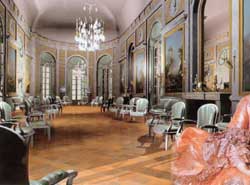 |
| Portrait by François Dumont dit l'Aîné; posted by George J. Homs on Geni.com |
Laborde acquired la Ferté-Vidame in the Eure from the heirs of the duc de Saint-Simon in 1764 at a cost of 1,550,000 livres. His son Alexandre later reported that the estate brought an annual revenue of 120,000 livres from wood and 100,000 livres from its farms, agricultural land, mills and ponds. In a letter to Choiseul of 1765 Laborde expressed his satisfaction at acquiring a historic house, "d'une forme mâle et antique", even though it would require extensive embellishment.
 |
| Image on a postcard - not sure about the original. LA FERTE VIDAME LE CHATEAU DE Mr DE LABORDE DETRUIT EN 1793 TBE (delcampe.net) |
I'm guessing they originally appeared in this guidebook produced in 1998 by the Amis du Perche.
An excursion from Verneuil to La Ferté-Vidame in August 1782
...the idea came to us... to go and see a beautiful and celebrated château, which strangers often visited out of curiosity. This was La Ferté-Vidame, the magnificent estate belonging to Mr de la Borde, the former Court banker and the richest private individual in France.
It was almost eleven o'clock in the morning when the idea came to us, and it already seemed too late to admire everything and be back in time for dinner. One of the servants, seeing our hesitation, repeated what he had hear said in the kitchen: that strangers who found themselves at La Ferté at meal times, were always invited to dine by M. de la Borde. This gave us hope and we were intrigued by the idea that we could count on receiving hospitality. We planned to show ourselves at the windows of the château, and to do all that we could to attract the attention of the master of the house. I still laugh at all our fears and precautions. I thought we should take my friend's cabriolet because it had springs. I forced him to change his old uniform coat en route, which he did, and we duly arrived at La Ferté, a distance of three leagues from Verneuil.
Since we ordered our coachman to go into the Courtyard and make a lot of noise with his whip, the porter at the gate asked us our names. He took them in writing to Mr de la Borde, leaving us transported with delight at the success of our plan....It was Mr de la Borde personally who came to reply, with an offer to eat at his table. We accepted quickly and gratefully.
Before dinner he gave us a conducted tour of the apartments. On the ground floor was a dining room with green and white stucco and the gallery or grand salon which had been added to the garden-side of the house... This gallery was decorated by superb Vernets; the two which hang at the crossing of the room must be among the chefs d'oeuvre of this talented artist.....
Works by M. Langrené the Elder, the current Director of the Academy, adorn the salon where the guests meet; these paintings are in poor taste, with an excessive use of colour...
Finally time for dinner arrived and we sat down table, enjoying ourselves marvellously; I was constantly about to burst in laughter at the memory of our little worries and a nudge of the knee of my companion at each dish.; after this boufonerie subsided and was succeeded by gratitude towards our hosts and admiration for the spectacle of happiness offered by the household.
Usually, when one is not born into fortune and luxury, riches create an unbearable arrogance; this is the reproach commonly made against financiers.. Since M. de la Borde was worth 30 million, I expected to find him thirty times more arrogant. Instead I saw only a simple and affectionate goodwill, and a bonhomie that I found charming. The two hosts, sitting at a corner of the table, distinguished themselves only by allowing themselves to caress in public, and the little attentions with which they showered us.
After dinner, a game of billiards was proposed and we had the humiliation, my friend and I, of being bested by the Mademoiselles de la Borde and de la Live. After that they desired to show us the park, which we toured, partly on foot and partly by coach, with the women. The walkways reveal magnificent courtyards preceded by two stretches of water. The parterre leads equally to vast water features and to the left, a jardin anglais, which would be my delight if I lived here. It was large, varied, imitating nature, and was noteworthy above all for the freshness of its green lawns, watered by a pretty stream that wound through it.... The walkways of the park were wide and enlivened by winding paths and plantations of trees (les 'bosquets'), as described by the abbé Delille in his Poème des Jardins: the prettiest had been named after Mr de la Borde's daughters....
Les Chatelains de La Ferté vidame de 1765 à 1784 (saint-simon-la-ferte-vidame.fr)
References
Château de la Ferté-Vidame — Wikipédia (wikipedia.org)
http://mairielafertevidame.fr/un-passe-glorieux/
- Later history of the château: .http://saint-simon-la-ferte-vidame.fr/de1784a1848.html
- The visit of Alexandre de Beauharnais: http://saint-simon-la-ferte-vidame.fr/de1765a1784.html
http://www.jstor.org/stable/23611415







No comments:
Post a Comment